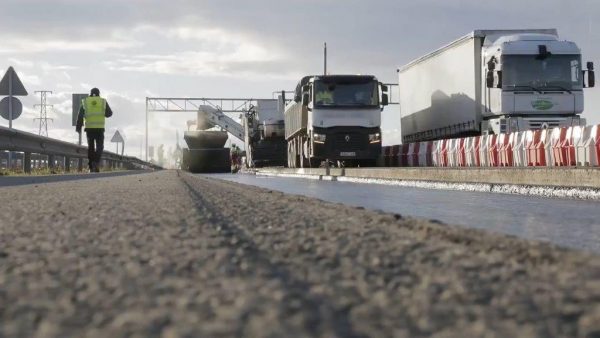
In June 1997, a re-asphalted stretch of the A-92 North between Granada and Murcia was opened to traffic without much fanfare. The pavement on this stretch was designed to withstand the temperature fluctuations of southern Spain. And it was mixed with recycled plastic from greenhouse roofs.
The project on using modified bitumen with recycled polyethylene from greenhouse roofs, developed by Ferrovial with collaboration from its subsidiary Ditecpesa, was in the works long before the concept of circular economy was so widespread.
In certain industrial circles, the idea of reusing and recycling to reduce waste had already become more significant in the 1990s. But the A-92 project was pioneering – especially if we consider that, to this day, applying the tenets of circular economy in road construction is uncommon.
Valuing waste, recycling and reusing to consume fewer raw materials, and reducing waste, in other words, closing the circle of using resources and raw materials. The circular economy is one of the priorities on the industrial and environmental agendas in many countries (the Spanish strategy is still in development) and the European Union. But how is this concept being applied to road construction?
On bitumen, binders, and durability
“In the circular economy, first and foremost is that the materials are long-lasting. Road durability depends on several factors, with the asphalt binder being one of the most important. The quality of the glue, in layman’s terms,” explains José Javier García Pardenilla, manager at Ditecpesa. “Rock or sand and bitumen [primary components of asphalt] don’t mix well chemically. But at high temperatures and with the energetic mixing process, we manage to mix them perfectly so that it becomes agglomerated, hard at room temperature.”
As such, it is common to modify the road’s top layers with polymer-modified bitumen, adding materials to increase the durability of the asphalt. “When we use polymers in bitumen, it’s like concrete mesh. The polymers form a three-dimensional network of long molecules in bitumen that give it consistency and elasticity, increasing the strength of the material,” adds García Pardenilla. And it is with these polymers that one of the significant advancements for roads in the circular economy has been made: reusing polymeric waste from other industries, such as plastics or tires.
In the search for even more resistant materials, progress has also been made in developing extreme climate bitumen (ECB). “We’ve managed to get bitumen and sand to mix well chemically. With nanomaterials, we can create covalent chemical bonds between bitumen and arid,” says Ditecpesa’s manager. This solution is specially designed for extreme climates, as it can withstand assaults from water, ice, and salt, though these properties do improve the life of any roadway.
 Reinforcing the roadways on the A2 motorway. | Ditecpesa
Reinforcing the roadways on the A2 motorway. | Ditecpesa
Recycling asphalt
What isn’t damaged doesn’t need to be reused or recycled. That is where the importance of the concept of road durability comes into play. Nevertheless, every material ends up suffering wear and tear. So then we should talk about recycling.
The passage of time, temperature changes, inclement weather, and use aren’t particularly bad for the materials that make up asphalt. Even when the road surface is damaged, bitumen and aggregates tend to perform over the years. What is lost is the property of conglomeration. “But if it is reprocessed, we get a new material that is exactly the same. Road asphalt can be recycled an infinite number of times,” explains García Pardenilla.
A milling machine is used to recover the used asphalt. This is a kind of toothed mill that breaks up the pavement and vacuums it up. The recovered material can be recycled on-site or at an asphalt plant. In either location, the milling has to be classified according to its size, approaching exhaustive control for the thick aggregates, fine gravel, and sand present.
“It’s not about milling the pavement and putting it right back,” says Ditecpesa’s manager. “If done properly, the resulting roadway is as good as the original. It can be completely recycled. After all, the materials barely break down, so you only have to add some new bitumen to replace what disappeared due to oxidation and check the size of the aggregates.”
One of the most recent cases in Spain is the reconstruction of the A-66 between León and Benavente, which Ferrovial Agroman carried out last year. Some 25% of recycled agglomerate (a mix of bitumen and aggregates) was used for this project.
From the recycle bin to roads
The roads in the circular economy are also a place to recycle or reuse materials thrown out by other industries. The bitumen modified with recycled polyethylene from greenhouse roofs at the start of this article is just one example. Currently, this polyethylene can be gotten from almost any plastic waste, such as PET and PEAD containers that come from the recycle bin.
Another circular solution for modifying bitumen with polymers (and increasing their strength) is to add tire powder to the mixture. However, to get the properties of a conventional polymer-modified bitumen using tire waste, it is necessary to increase manufacturing temperatures, in turn increasing greenhouse gas emissions.
Reducing the environmental impact of human activities is not simple, and there is no one answer. In fact, though not in the circular economy, another of the most researched solutions for strengthening road sustainability is lowering the manufacturing temperature of agglomerate in the plant and thus reducing emissions.
Eyes on a new mobility model
 Electrification and autonomous driving will reduce the environmental impact of transportation. | Unsplash/Samuele Errico Piccarini
Electrification and autonomous driving will reduce the environmental impact of transportation. | Unsplash/Samuele Errico Piccarini
100% effective asphalt recycling, reusing waste, and long-lasting materials. “In the circular economy, technically, there isn’t much room for improvement. Today, everything can be reused. The technology is there,” says José Javier García Pardenilla. “The next step is increasing the recycling rate, which is still very low in Spain. The goal should be determining a point at which no agglomerate is thrown out.”
We have the how, but a political and industrial decision is needed to make roads in the circular economy a reality. A conglomerate of determination, investment, and trust, with an eye on the future in the medium and long terms – a future where new mobility models, once fully implemented, reduce demands on infrastructure.
“When self-driving cars get here, everything should be more efficient. There will be fewer cars, many will be shared, manufacturing costs will go down, and the environmental impact will improve due to electrification. The infrastructure will be the same, and you’ll need to have higher-quality standards for self-driving cars, but the system will be better organized,” Ditecpesa’s manager concludes.






There are no comments yet